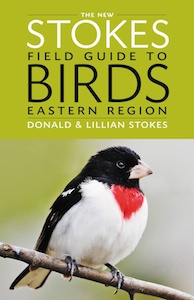When it comes to American bird watching, few names are better known or more widely respected than those of Donald and Lillian Stokes. For decades the couple have worked together to write and publish more than thirty books on bird watching and nature study – many specifically directed toward the beginner and backyard segments of the bird watching community. Indeed, the Stokes have achieved such a level of renown from their dedication to producing helpful books and other bird watching related items popular with the widest swath of the North American bird watching population that they are some of the few people ever to have had a widely viewed bird watching series broadcast on American television.
Thus it’s not surprising that when a pair of new field guides written by the Stokes is published, such as was recently the case with the release of The New Stokes Field Guide to Birds: Western Region & The New Stokes Field Guide to Birds: Eastern Region that it is a cause for much attention and discussion. Building and greatly expanding upon their previous guide, The Stokes Field Guide to the Birds of North America, originally published in 2010, these two new guides can reasonably be said to have divided and conquered the problem of increasingly over-large and too-wide-ranging field guides that are regrettably becoming the norm in the United States.
By vertically dividing the Continental U.S. and Canada roughly in half, the Stokes have managed to include a generous number of species (636 in the Western volume, 545 in the Eastern) in each volume, depict each one with multiple full-color photographs accompanied by informative descriptive text and range maps, and still manage to keep each volume under 600 pages in length in an easily portable 5 1/2” x 8 1/2” format.
Needless to state, the Stokes use every bit of available space on each page – including the inside of each cover – to ensure that as much information as might reasonably be useful in the field is included. As this is a photographic guide, the plates naturally take pride of place. Half of each species citation (and a good deal more in the cases of some gulls) is dedicated to full color photos – each quite obviously carefully selected to depict an important field mark or plumage, and each marked with both the location and month in which it was taken.
All the normally expected descriptive apparatus for each species are included, as well as a few helpful items that might not be; American Birding Association codes, for example. Color coded range maps (of a slightly smaller size than might be preferred) are featured on each species page, and a helpful quick location color band across the bottom of each page allows for rapid location of family groups within the book.
Thus for all those seeking an up-to-date photographic field guide that well balances a healthy amount of practical information with ease-of-use and portability, either of The New Stokes Field Guides should be given serious consideration as a possible future addition to your field bag or day pack.
 Title: The New Stokes Field Guide to Birds: Western Region & The New Stokes Field Guide to Birds: Eastern Region
Title: The New Stokes Field Guide to Birds: Western Region & The New Stokes Field Guide to Birds: Eastern Region
Authors: Donald & Lillian Stokes
Publisher: Little, Brown, and Company
Imprint: Little, Brown, and Company
Format: Paperback
ISBN: (Western) 9780316213929; (Eastern) 9780316213936
Pages: (Western) 592; (Eastern) 512
Date of Publication: 26 March 2013
In accordance with Federal Trade Commission 16 CFR Part 255, it is disclosed that the copy of the book read in order to produce this review was provided gratis to the reviewer by the publisher.
This review was originally published in the January / February 2014 issue of Bird Watcher’s Digest.

Review Roundup: March, 2014
April 11, 2014 @ 18:34
[…] The Well-read Naturalist […]